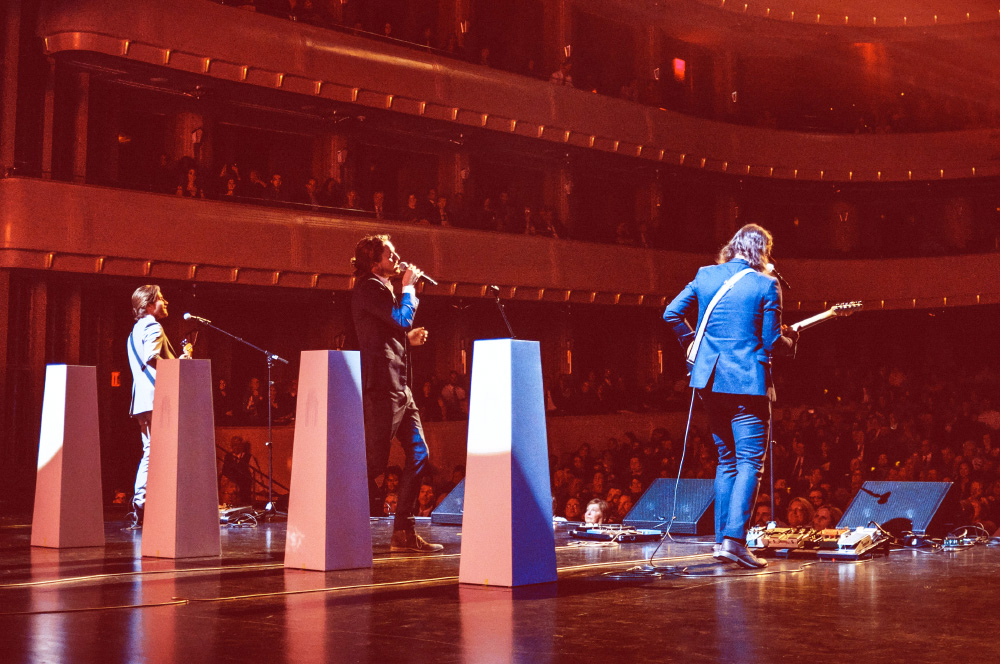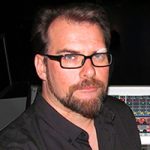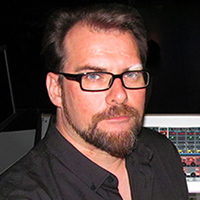Whenever we record music there are certain “golden rules” that aid us in getting the end results we require. These rules are based on years of experience and have been handed down from engineer to engineer as a useful guide to the best practices. While they’re not rigid, experience has taught us that it is wise not to break them if we hope to produce a recording of the required standard (i.e., to be released).
When recording a live concert we tend to rely heavily on these rules because we’re no longer in the controlled environment of the recording studio. The needs of the recording are secondary to the immediate requirement of running the show and providing a pleasing live experience for the audience, not to mention the fact that there’s only one take.
For a few years now I’ve been working as front of house engineer for a band that produces vibrant and energetic live shows, so I suggested trying to capture that energy by recording a live album. An upcoming European tour presented an opportunity but there was no budget available so I had to borrow what equipment I could in order to achieve this aim. The process caused me to pretty much break every one of the golden rules, yet the result was a releasable album.
Making The Math Work
The band consisted of seven musicians playing 10 instruments: full drum kit, bass guitar, acoustic guitar, electric guitar, charango (a 10-stringed South American instrument traditionally made from the shell of an armadillo), strum stick (a three-stringed instrument designed to be simple to play), violin, melodica, trumpet and clarinet. Combine all of that with two additional floor toms (used for the encore) and three vocals, and there was a grand total of 27 inputs. We had a Korg D888 (eight-track, eight-channel, eight-bus) hard disk recorder, and this is where I broke my first rule…
Rule 1: Always record all inputs separately.
Due to the inherently fleeting nature of live performance, it’s wise to record every single stage input on a separate channel because this enables maximum flexibility when it comes to treating and blending the individual elements into the final mix. It also provides the ability to repair any mistakes and even overdub replacement or additional parts – believe it or not, very few live albums are “warts and all” unaltered depictions of the actual event. In the context of a live concert any wrong notes or mistakes are fleeting and soon forgotten, all part of the immediacy of live music.
But if those same mistakes are captured on a live recording and replayed multiple times they quickly become glaringly obvious, jumping out every time you listen to it. So the ability to separate individual instruments and repair, if necessary, can be vital.
However, the recorder afforded no such luxury. I had to find a way to get those 27 inputs down to eight. The key was the realization that while there were multiple instruments on stage, there were still only seven musicians, and while they’re a talented bunch, none of them have yet figured out how to play two instruments at once (Figure 1). All I had to do was assign one channel to each musician (while separating the lead and backing vocals), which resulted in the following track listing:
1 – Drums
2 – Bass
3 – Guitars (acoustic, electric, charango and strum stick)
4 – Violin (plus melodica)
5 – Trumpet
6 – Clarinet (top and bottom microphones)
7 – Lead vocal
8 – Backing vocals
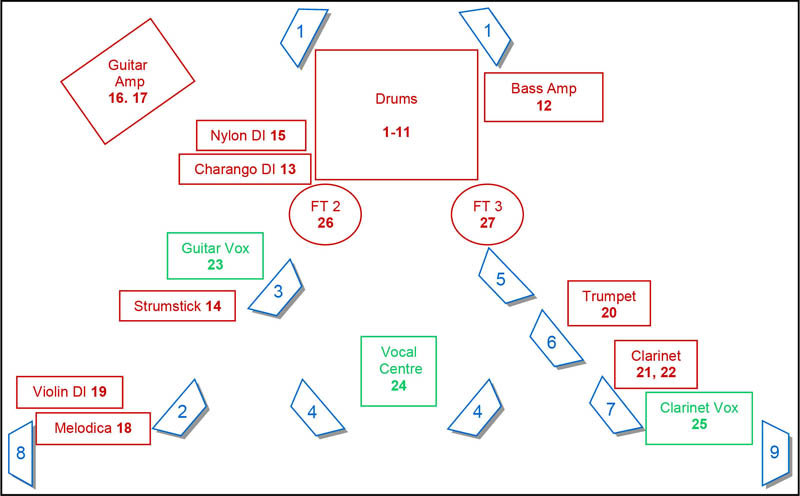
The hardest decision I had to make was to record all of the drums to one channel. This would be a major issue in the final mix, but there was simply no choice. A drum kit comprises multiple elements that cover the widest frequency range of just about any instrument (with the possible exception of the pipe organ). It’s also a physically wide instrument that benefits from spatial separation of the individual elements via panning, an option which would now be denied because I was recording all 11 inputs in mono on one track.
Rule 2: Always record the raw input signals.
The common practice when recording a live show is to use a splitter to take a complete copy of all of the stage inputs and thus record them before they’re relayed to the front of house/monitor consoles. This ensures capturing the raw signals unaffected by any processing employed for the live mix.
The reason for this rule is that the demands of the recording mix are quite different from those of the live mix. The live mix is comprised of those elements required to reinforce and enhance the ambient sound coming from the stage to create a clear, precise and above all visceral experience for the audience.
The recording mix is much more about presenting a coherent sound that attempts to reproduce the energy and excitement of the concert that will withstand repeated listening.
The live mix is also designed to work on a specific sound system in a particular room, whereas the recording mix needs to take into account the fact that the end result will be listened to on a wide variety of reproduction equipment in various environments. The requirement of recording to eight tracks meant a splitter was not an option.
For the three tracks with just one input (bass, trumpet and lead vocal), I was able to use the desk channel direct outputs to record an unprocessed signal. For the other five tracks, there was no choice but to use subgroups to combine the channels I needed, which meant those signals would be post everything (i.e., inserts, EQ and fader).
This required that I be acutely aware at all times of how any of the processing would affect the recording mix, and to try to seek a compromise between the demands of the two outlets. Thankfully my methods for applying EQ, gates and compressors are quite subtle so I was confident this would work; the key was being careful not to make any large or sudden moves.
Rule 3: Always employ redundancy and have a backup recording system.
You only get one take at a live recording, so any equipment failure that causes the recording to fail is catastrophic. A second recorder, ADAT machine or laptop can provide a handy back-up should the primary device fail, and this redundancy should be considered a vital part of the recording set-up.
However, this option wasn’t available on this project, so I decided that the best option would be to record all 15 shows on the tour and hope that the best performances could be compiled into a coherent album.
Rule 4: Adequately capture the audience/ambient sound.
Hearing the crowd respond to the live performance really helps the listener to immerse themselves in the playback and imagine they’re present at the concert. Ambient microphones will also pick up some of the sound of the band and PA system propagating in the room which, when added to the dry multi-channel recording, can really add life and glue the whole recording together.
But because the recorder didn’t have any additional tracks available, I came up with the simple solution of recording the audience sound separately using a stereo microphone plugged into my laptop. This meant I would have to manually synchronize the two recordings in the mix, but there really wasn’t any other choice.
Necessity & Invention
By far the biggest challenge in the mix was to inflate that single track of mono drums into something resembling a full-fledged drum kit – it would sound weak if the drums weren’t pumping.
The solution was to duplicate the drum track four times and EQ each of the copies differently: one low-passed to bring out the kick, one band-passed to bring out the snare, and a pair high-passed to act as overheads (one of which was delayed a small amount to create a pseudo-stereo effect when panned). This enabled me not just to modify and mix the key elements of the kit, but also to apply reverb only where I wanted it.
The tracks featuring multiple inputs, which I had been forced to record post fader via subgroups, actually presented few problems. The fader moves done live translated well to the recording mix, balancing the instruments in the same way I had done live. Any wayward fader movements were easily corrected with fader automation.
The decision to record multiple shows in lieu of having a backup system resulted in many hours of recordings to trawl through to find the best performances, but fortunately there were no issues with the equipment and we managed to capture every note of every show.
Synchronizing the audience tracks with the eight-track recording proved to be fiddly but ultimately straightforward. In most cases, there were stick hits on the drum tracks that could be used to visually align them. I then fine tuned the alignment by panning the audience recording to one side and the eight-track recording to the other so that when I listened on headphones it was much easier to identify and correct any timing discrepancies.
About halfway through the project, I needed to go out on tour again but the mix needed to be finished, leading me to break one last golden rule.
Rule 5: Never mix exclusively on headphones.
When we listen to music via loudspeakers, our ears don’t just hear the signal from the nearest loudspeaker(s), they also hear signal from the further loudspeaker(s), which is slightly obscured by the acoustic shadow of our head. There are also reflections from the walls, ceiling and floor that combine in a complex way to create what we consider to be a natural sound.
But when using headphones, the left ear only hears signal from the left loudspeaker, and vice versa, which can make it harder to judge the sound and positioning of individual elements as well as the mix as a whole. This is why it’s generally considered a bad idea to mix exclusively on headphones.
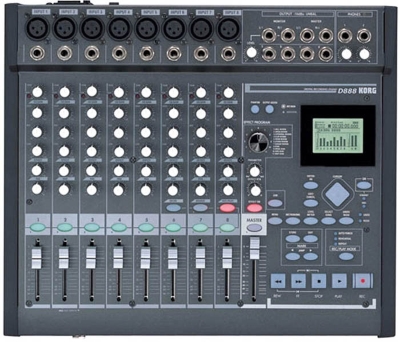
The requirement to finish the recording mix while on tour meant I had no choice but to use headphones. Therefore, I had to trust the EQ and panning decisions made when mixing on loudspeakers, using them as my reference points for making any further changes to the mix. Every time I made a major change, it was saved as a different incremental version so that I could constantly reference back to the original to make sure I wasn’t straying too far from the path.
Different Path
The series of decisions forced by equipment restrictions ultimately resulted in spending much more time on the project than if I’d done it “by the book.” A healthy combination of stubbornness and perseverance helped in achieving the desired result of producing a releasable album, but this project would not have been possible without modern hard disk recording technology and DAW software.
While I enjoyed the challenges, this is not a path I recommend. Let it be an object lesson in how not to record a live album.

